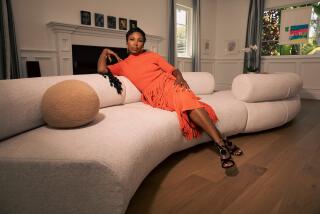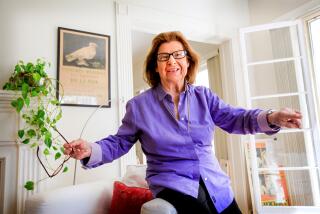Elizabeth Tilberis; Magazine Editor Cancer Crusader
- Share via
Elizabeth Tilberis, the editor in chief of Harper’s Bazaar who became a crusader for ovarian cancer research after she was diagnosed with the disease at 45, died Wednesday in New York City. She was 51.
A well-respected and powerful force in the fashion community, Tilberis helped raise awareness of the disease and worked diligently to raise funds for a cure.
Born a country doctor’s daughter in the north of England on Sept. 7, 1947, Tilberis’ career in fashion brought her to London, where she worked at British Vogue for 23 years, then to New York, where she led Harper’s Bazaar for more than six years.
Tilberis considered herself an editor who was more excited by visual images than the written word. But according to her friend Ralph Lauren, she “turned Harper’s Bazaar into a sleek, contemporary magazine read by everyone from mothers in the Midwest to fashion junkies on Seventh Avenue.”
Although her position as editor in chief of British Vogue and Harper’s Bazaar put her at the top of the glamorous world of international style, Tilberis didn’t fit the stereotype of a haughty, inaccessible fashion maven. She was known for her broad smile, and until she became ill, she was a 150-pound, size 14 who balanced marriage, motherhood and her career.
In her 1998 autobiography, “No Time to Die,” she recounted how desperately she wanted a family. In the book’s most controversial assertion, she blamed fertility treatments she underwent in her 20s for triggering her cancer.
When fashion shows became regular fodder for cable TV, Tilberis became a self-described “mini-celebrity,” offering sound bites on the state of style. But her appearance had changed. Chemotherapy treatments resulted in a dramatic weight loss, and her white hair was cropped into a short pixie cut.
Tilberis first wrote about coping with cancer in Harper’s Bazaar in 1994. The response to two stories, one describing her diagnosis and first course of treatment, the second detailing the agonizing bone marrow transplant she underwent two years later, elicited such a strong response from readers that Tilberis decided to write the book. Breast cancer research already had been widely supported by the fashion industry. Tilberis wanted ovarian cancer to be comparably publicized.
“Breast cancer went a long way to convincing the medical profession that women really want to know about their health. They will not be passed by, they will not be put off, and I think that’s terribly important,” she said in a 1998 interview.
Tilberis became an enthusiastic role model for women with cancer. “In one way, I’m terribly proud that I’ve been able to tell my story,” she said, “because if I can save even one life, that would be a major triumph. On the other hand, it’s kind of scary. I find myself saying things that are overly medical. When you’ve had a disease like cancer, you know an awful lot, but it’s a matter of a little learning being a dangerous thing. I’m wary of not trying to overstep the bounds of medical things that I don’t really know about, which is hard to do sometimes.”
As president of the Ovarian Cancer Research Fund, Tilberis devoted considerable time to fund-raising. Through friendships with the biggest names in fashion, including Gianni Versace, Karl Lagerfeld, Calvin Klein and Donna Karan, she was able to bring the sort of celebrities to her cause that attract both attention and money.
Her most well-known friend was Diana, princess of Wales, who presented a special award from the Council of Fashion Designers of America to Tilberis in 1994. Harper’s Bazaar received two 1993 National Magazine awards under Tilberis, and in 1994 she was named Advertising Age’s editor of the year.
Although Tilberis was occasionally hospitalized for treatment, she took very little time off from running the magazine. If editorial meetings had to be conducted in her hospital room, the staff would gather around her bed.
Trained as a designer, Tilberis admitted she had little talent for it. But she loved clothes and photography. The former Elizabeth Kelly began working at British Vogue after graduation from Leicester Polytechnic in 1969, and married her art school professor, Andrew Tilberis, in 1972. When fertility treatments proved unsuccessful, the couple adopted two sons, now 14 and 17.
Andrew Tilberis is an artist and inventor, but as his wife’s career blossomed, they agreed that he would primarily be a househusband. Elizabeth Tilberis found New Yorkers more accepting of that role than her peers in Britain had been. In New York, where the financial, literary, theatrical fashion and art worlds mix, the Tilberises were part of a cross-professional social elite. They lived in Manhattan, and had a weekend home on Long Island.
In her years in fashion, the industry became increasingly international. Models and photographers worked everywhere, and consumers throughout the world clamored for the same designer labels.
“Everything changed when the realization hit that there was a lot of advertising in fashion, and a lot of money to be made,” she said.
She believed it was important that Harper’s Bazaar maintain a standard of elegance. “We’re probably the most elitist fashion magazine in America today, and I think we should remain that,” she said. “I lie awake nights thinking, ‘I suppose I should get more commercial.’ But in the end, America will all just eat McDonald’s and sit on the same chair if we’re not careful. I think my vocation in life is to keep the beauty of the cutting edge of fashion alive.”
Aimee Lee Ball, who co-wrote “No Time to Die,” said at the time of the book’s publication: “When we were working on the book, I had knee surgery. She was always so solicitous about my health. Compared to what she had been through, I felt like such a baby. She was the first one to be concerned about other people. She isn’t one to ask, ‘Why me?’ Her attitude is, what do I have to do to fix this? Certainly, she’s had moments when she’s cried bitter tears, but her public persona is, let’s get on with it.”
In addition to her husband and two sons, Tilberis is survived by her mother, a sister and a brother.
In honor of her work, the family has requested that any memorial donations be sent to the Ovarian Cancer Research Fund, One Pennsylvania Plaza, Suite 4800, New York, N.Y. 10119-0165.






